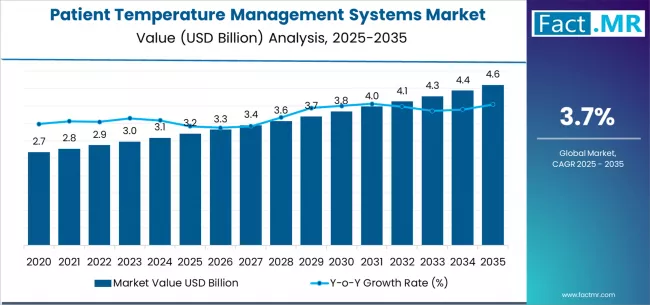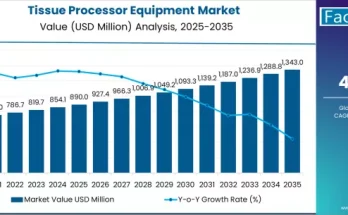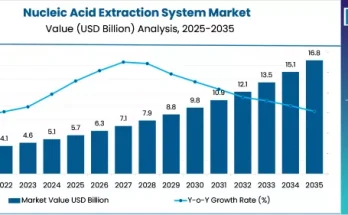The global patient temperature management systems market is poised for steady growth through 2035, driven by advancements in perioperative care, rising surgical volumes, and a growing emphasis on improving patient safety outcomes. According to the latest analysis by Fact.MR, the market is valued at USD 3.2 billion in 2025 and is projected to reach USD 4.6 billion by 2035, marking an absolute increase of USD 1.4 billion over the period. This reflects a compound annual growth rate (CAGR) of 3.7%, underscoring the market’s pivotal role in modern clinical care environments.
As healthcare systems focus on minimizing post-operative complications, managing hypothermia, and ensuring thermal stability in critical care settings, patient temperature management systems are becoming indispensable across hospitals, ambulatory surgical centers, and emergency care facilities.
Strategic Market Drivers
- Rising Surgical and Critical Care Demand
The increasing number of surgical procedures—spanning cardiac, orthopedic, and neurosurgical interventions—is a primary growth catalyst. Maintaining optimal patient temperature during perioperative and recovery stages significantly reduces infection rates, blood loss, and hospitalization duration. Healthcare providers are thus prioritizing advanced warming and cooling solutions to achieve better clinical outcomes. - Technological Advancements in Thermal Regulation
Modern temperature management systems leverage closed-loop feedback, AI-based monitoring, and microprocessor-controlled devices for real-time thermal precision. These innovations are enhancing patient comfort and improving outcomes across both acute and chronic care environments. - Growing Focus on Patient Safety and Cost Efficiency
With healthcare reforms emphasizing value-based care, hospitals are investing in patient temperature management systems to prevent hypothermia-related complications and reduce readmission rates. Integration with electronic medical records (EMRs) also enables better tracking and compliance with surgical safety protocols. - Increasing Demand from Geriatric and Chronic Care Segments
The expanding aging population and rising prevalence of chronic conditions such as cardiovascular and respiratory diseases are driving adoption of these systems in intensive care and recovery units to support continuous patient monitoring and thermal homeostasis.
Browse Full Report: https://www.factmr.com/report/171/patient-temperature-management-systems-market
Regional Growth Highlights
North America: Clinical Adoption and Technological Leadership
The U.S. dominates the global market, fueled by the region’s advanced healthcare infrastructure, high surgical volumes, and early adoption of smart monitoring technologies. Manufacturers are focusing on automated and portable temperature management systems designed for perioperative and trauma care.
Europe: Regulation-Driven Expansion
European healthcare facilities are increasingly adopting temperature management solutions that meet stringent patient safety and hygiene standards. The region’s focus on precision medicine and post-operative care optimization has accelerated system upgrades in hospitals across Germany, France, and the U.K.
Asia Pacific: Expanding Healthcare Access and Modernization
Rapid infrastructure development, growing medical tourism, and increased public healthcare investment across China, India, and Japan are driving strong regional momentum. Expanding access to advanced surgical and ICU facilities is boosting demand for both warming and cooling systems.
Emerging Regions: Latin America, Middle East, and Africa
Government-led hospital modernization programs and rising trauma care needs are stimulating market adoption. Vendors are introducing cost-effective and portable systems tailored to regional requirements and healthcare budgets.
Market Segmentation Insights
By Product Type:
- Warming Systems – Forced-air, conductive, and fluid-based systems for surgical and recovery applications.
- Cooling Systems – Surface and intravascular cooling solutions used in therapeutic hypothermia and cardiac arrest management.
By Application:
- Surgery and Recovery – Core application area, ensuring perioperative thermal stability.
- Acute and Critical Care – Intensive use in ICUs, emergency, and trauma care.
- Newborn and Pediatric Care – Temperature stabilization during neonatal transport and treatment.
By End User:
- Hospitals
- Ambulatory Surgical Centers (ASCs)
- Specialty Clinics and Trauma Centers
Challenges and Market Considerations
Despite promising growth, the industry faces key challenges:
- High Capital and Maintenance Costs: Limit adoption in small and mid-tier healthcare facilities.
- Stringent Regulatory Approvals: Lengthy certification processes delay product commercialization.
- Technological Integration Gaps: Lack of interoperability with hospital information systems can reduce operational efficiency.
- Limited Access in Developing Regions: High costs and infrastructure limitations constrain penetration in low-income markets.
Competitive Landscape
The global patient temperature management systems market is moderately consolidated, characterized by continuous product innovation and strategic partnerships aimed at expanding clinical reach.
Key Players in the Patient Temperature Management Systems Market:
- 3M Company
- Smiths Medical (part of ICU Medical, Inc.)
- Gentherm, Inc.
- Stryker Corporation
- Becton, Dickinson and Company (BD)
- Medtronic plc
- GE HealthCare
- Zoll Medical Corporation
- Belmont Instrument Corporation
- The Surgical Company
These companies are enhancing product capabilities through R&D in sensor-driven technologies, biocompatible materials, and energy-efficient control systems.
Recent Developments
- March 2023 – Gentherm, Inc. launched its ThermoSmart Platform, integrating AI-driven patient temperature analytics for ICU environments.
- October 2022 – Stryker Corporation expanded its Altrix Precision Temperature Management System across European hospitals to support enhanced perioperative safety.
- September 2022 – 3M Company introduced upgraded Bair Hugger Warming Systems with advanced airflow control to minimize contamination risk in operating rooms.
Future Outlook: Intelligent and Personalized Temperature Management
The next decade will redefine the patient temperature management landscape with a focus on digital integration, predictive analytics, and patient-centric design.
Manufacturers are developing wireless, wearable thermal devices, and AI-assisted platforms that adjust temperature parameters in real-time, enhancing both patient comfort and safety.
As global healthcare systems prioritize operational efficiency, clinical safety, and sustainability, the patient temperature management systems market is set to maintain a robust growth trajectory. Companies that align innovation with regulatory compliance and cost efficiency will shape the future of smart and sustainable thermal management in healthcare.



